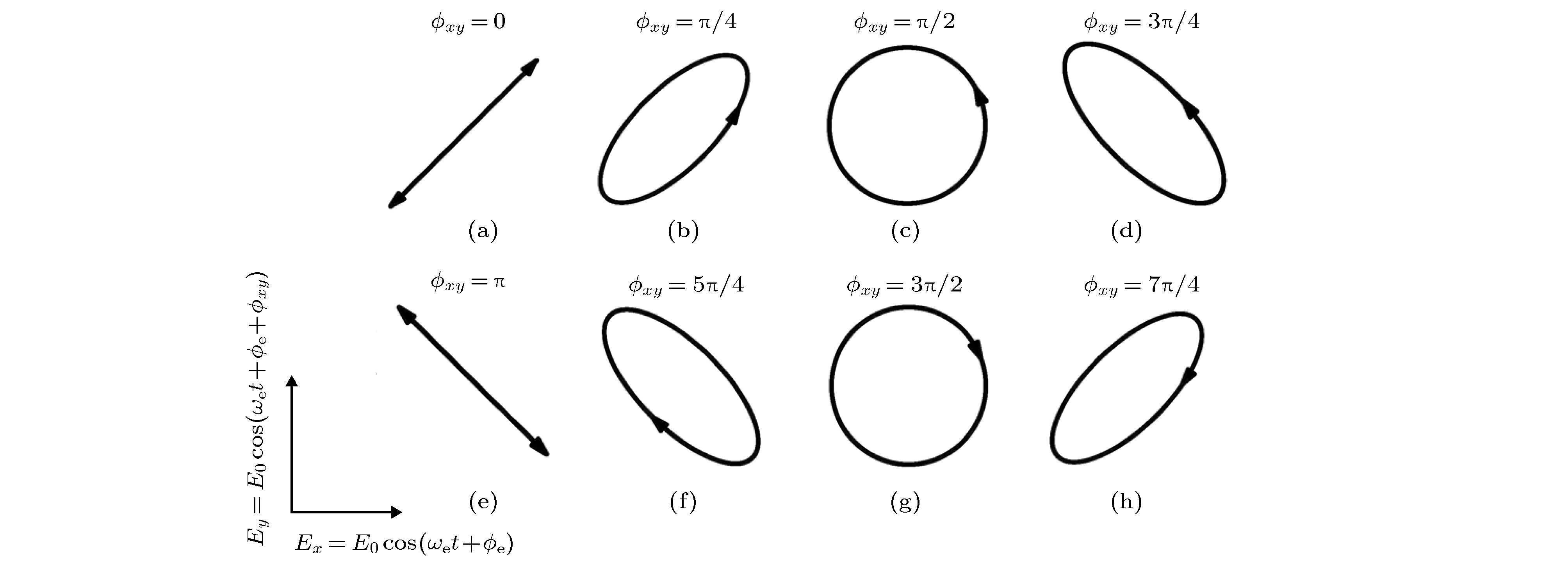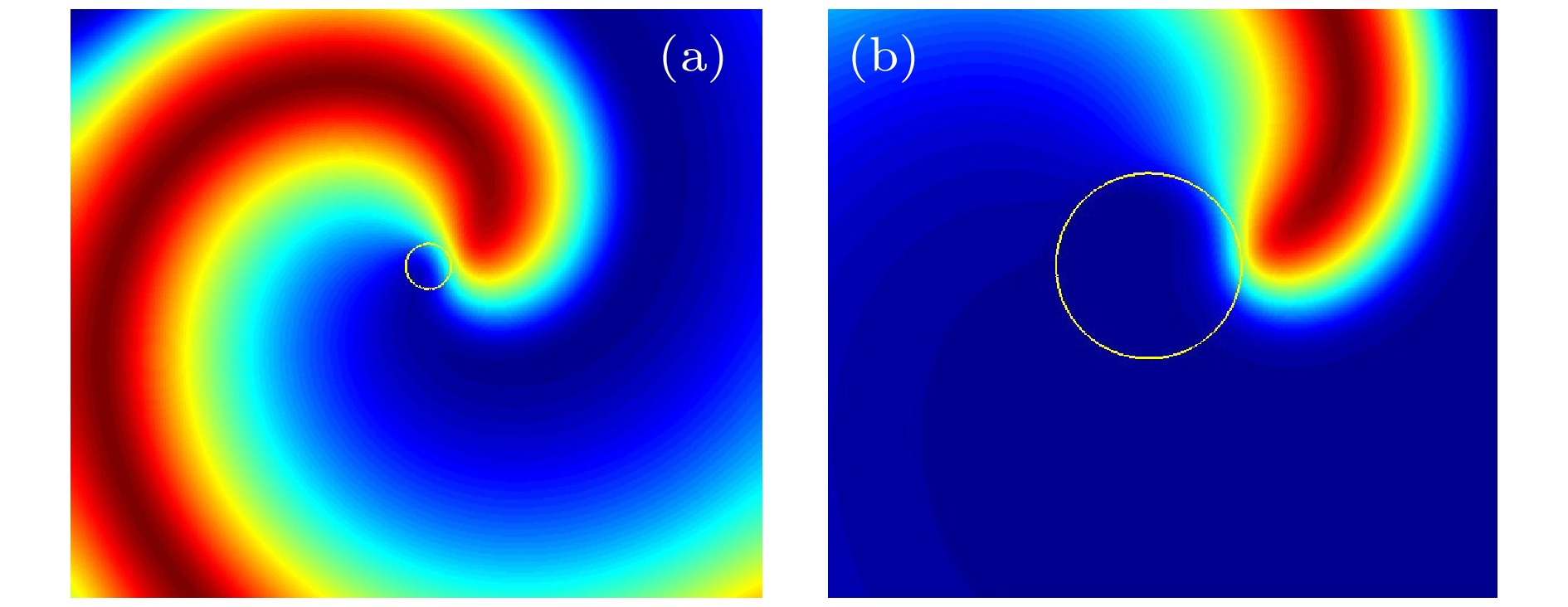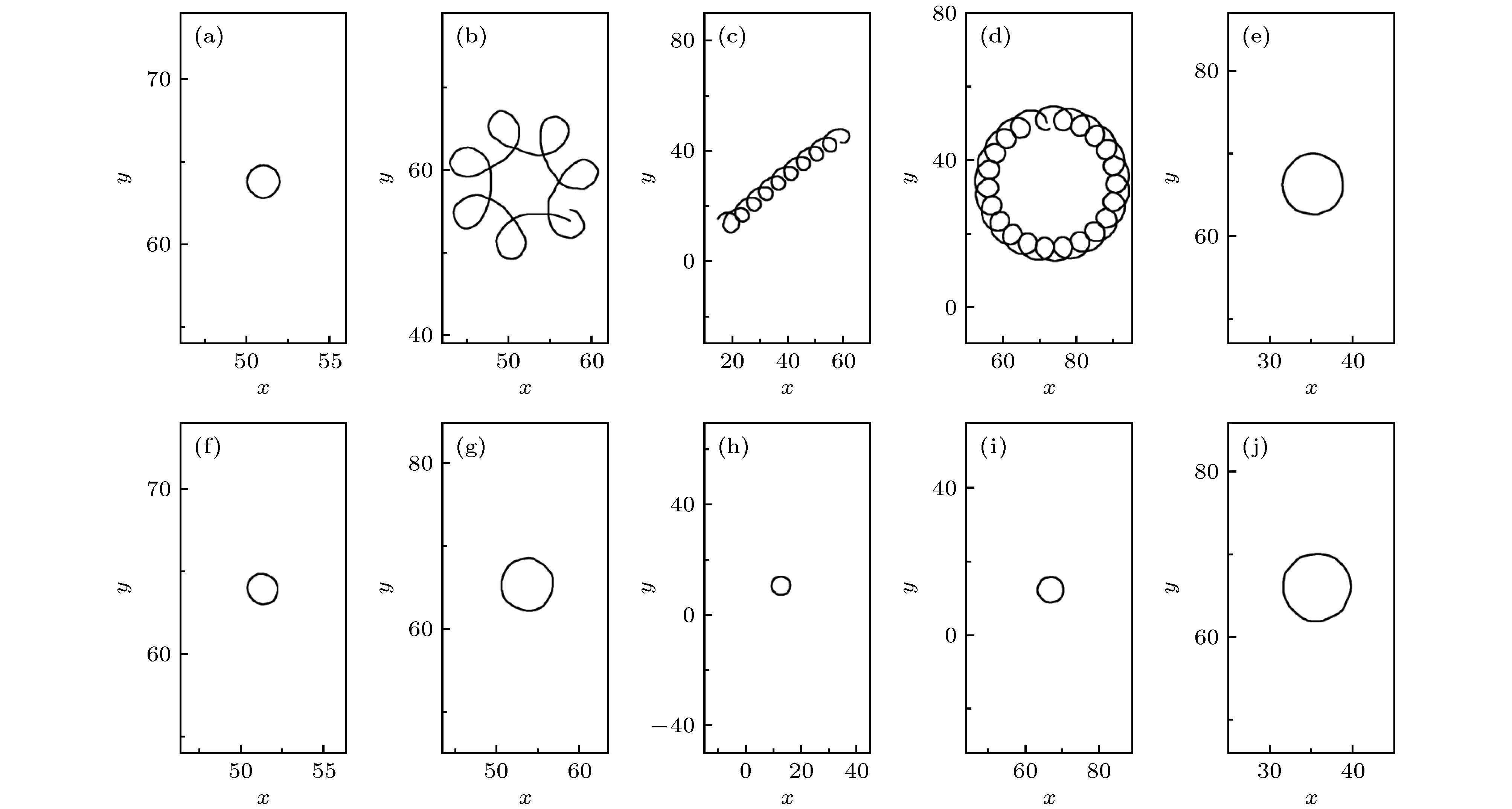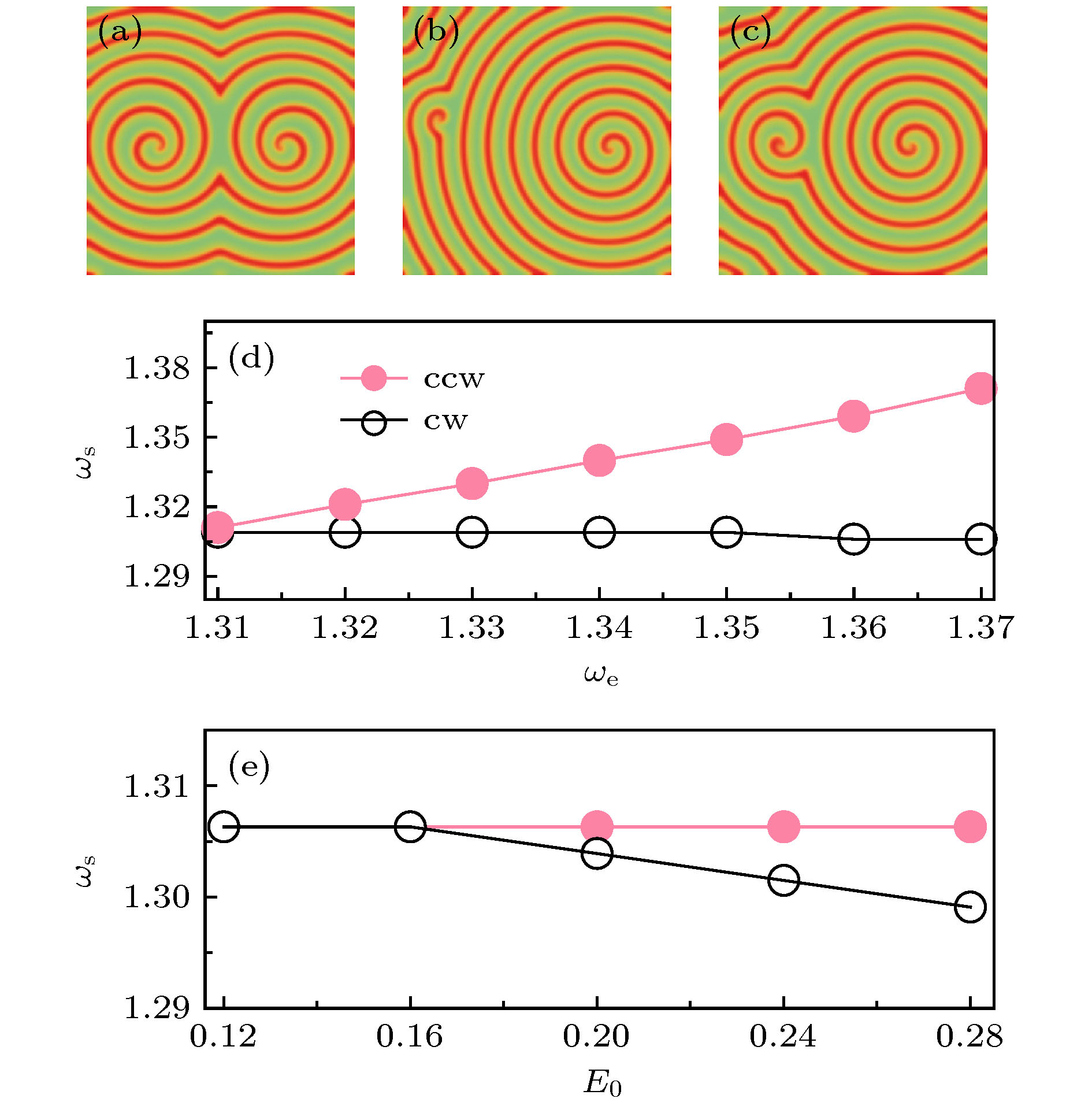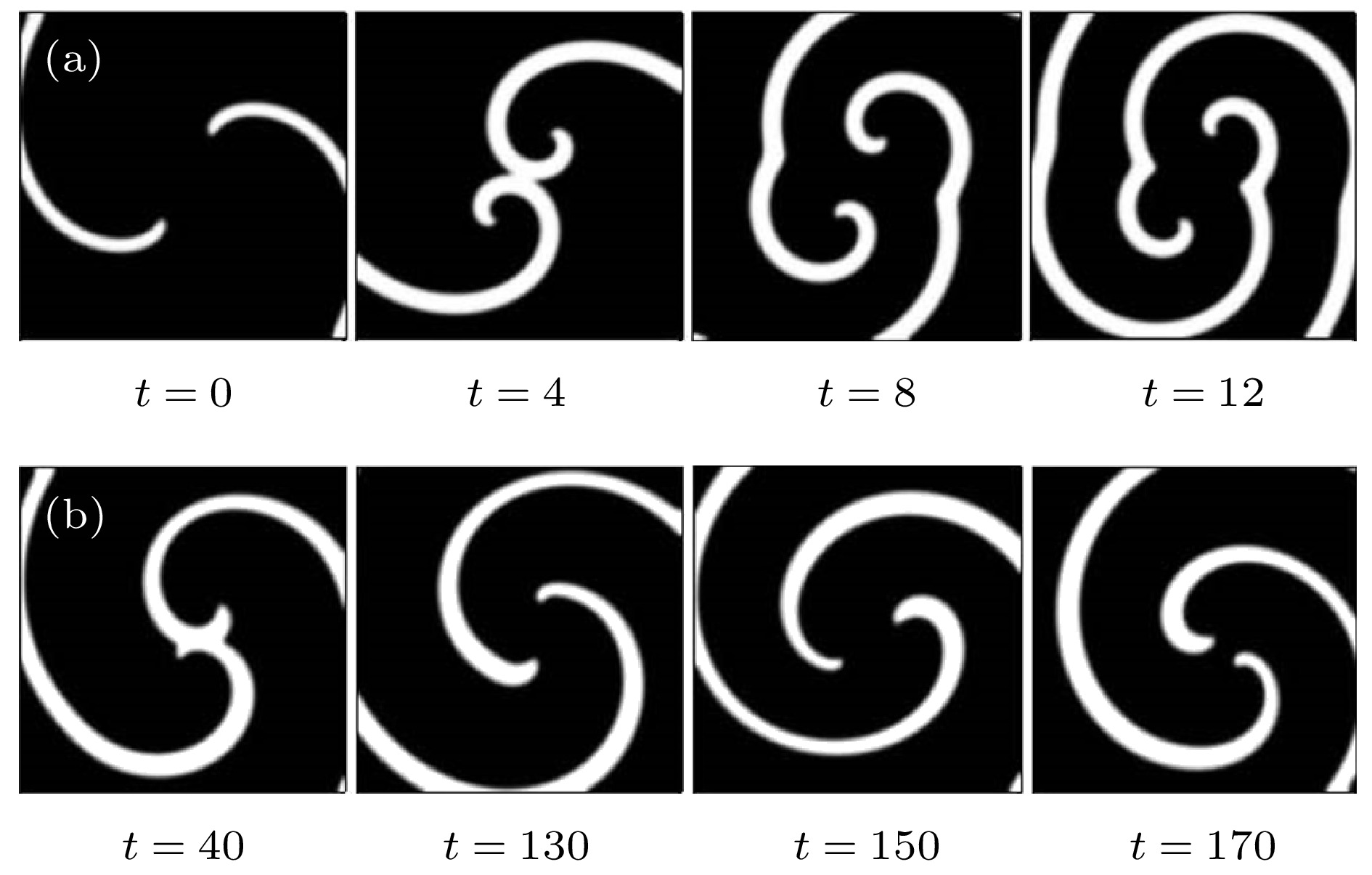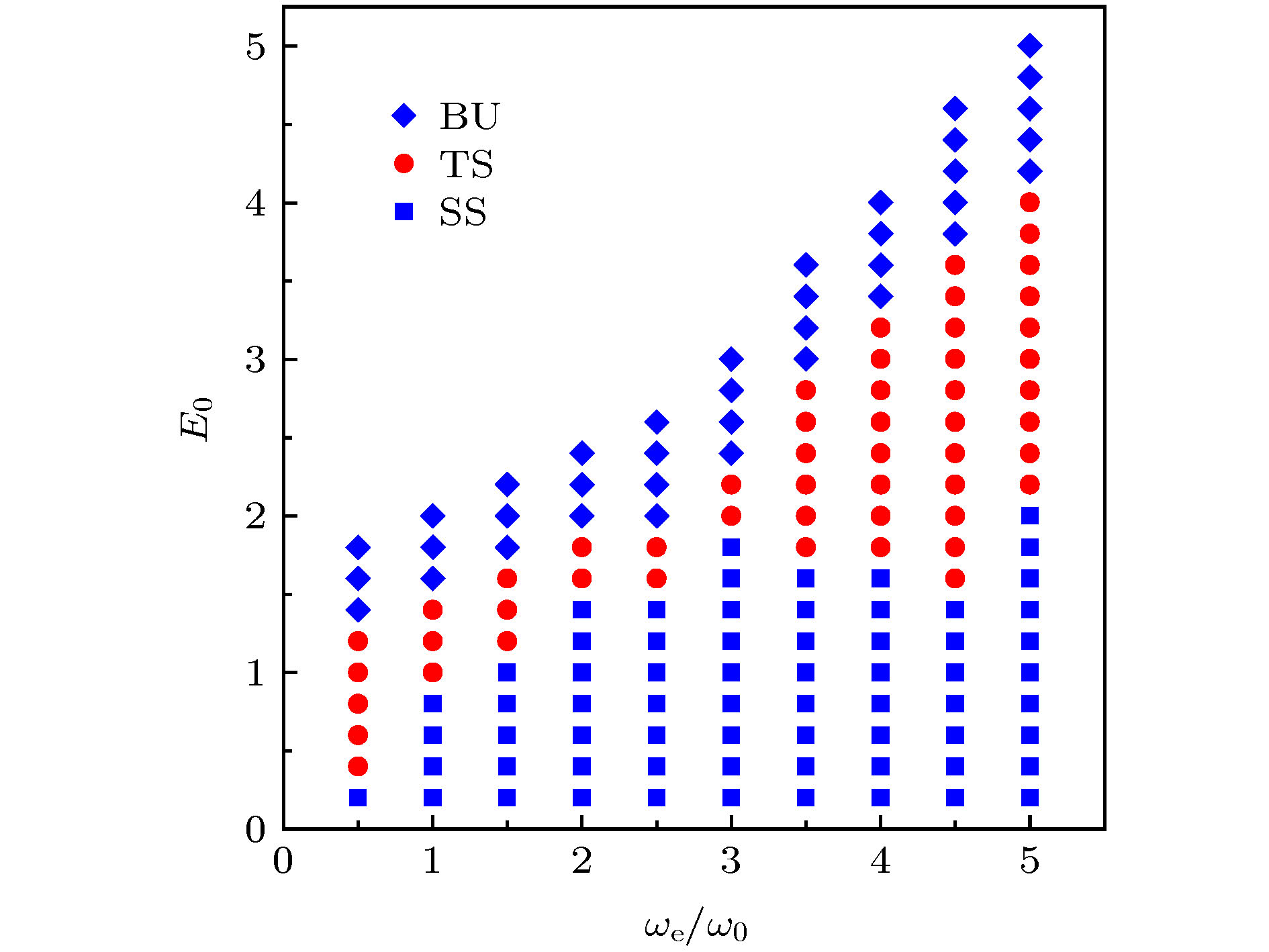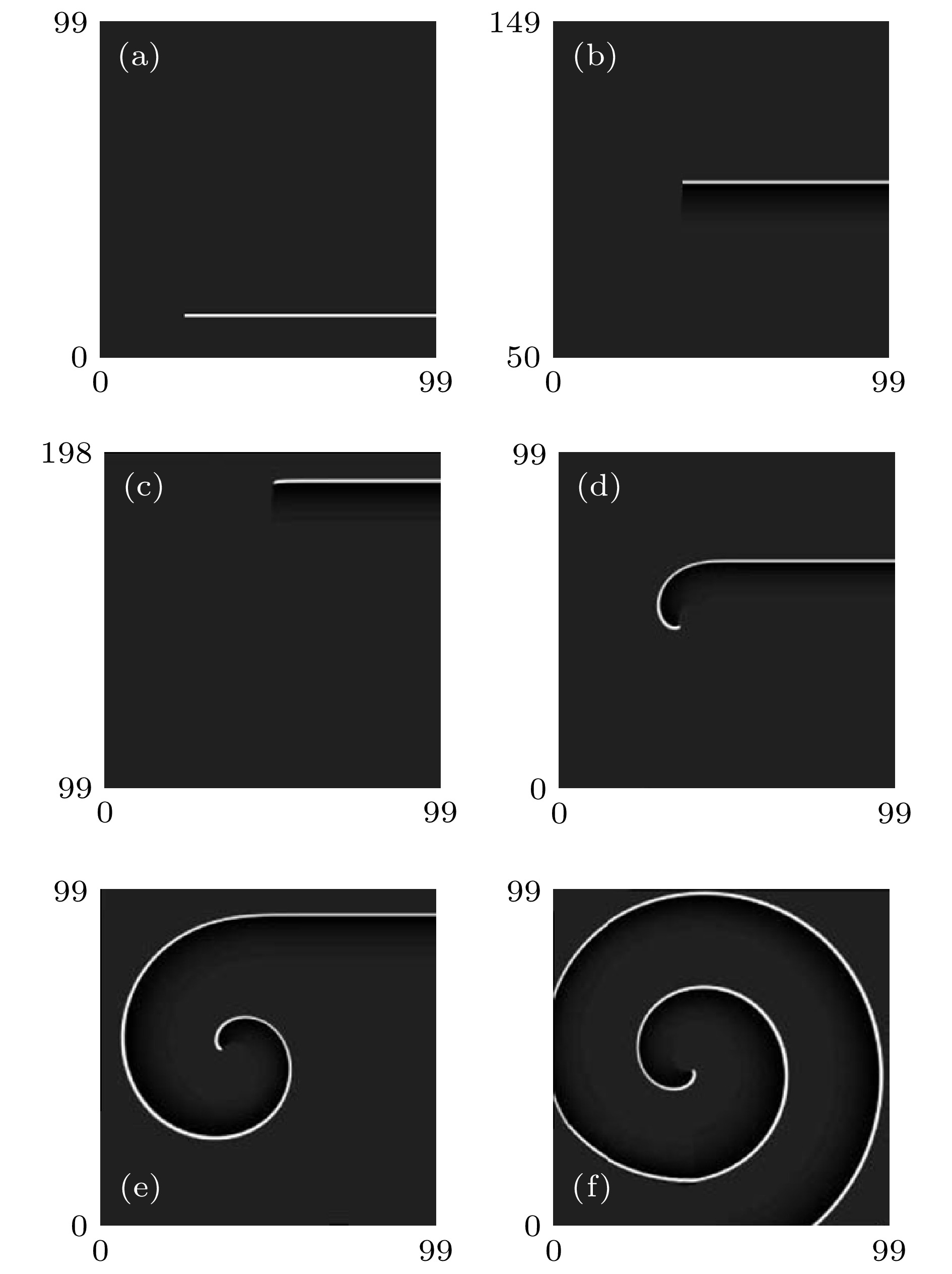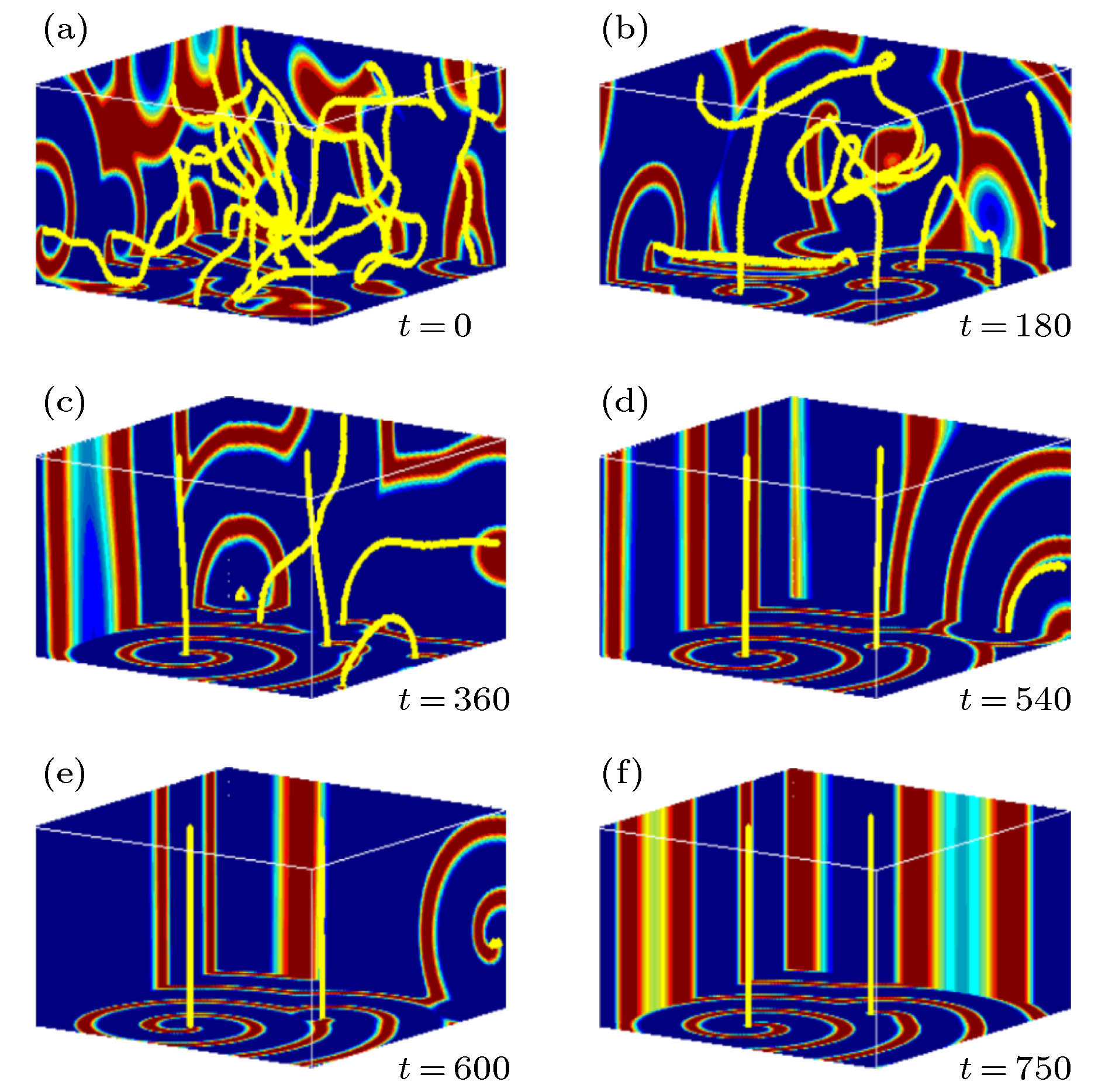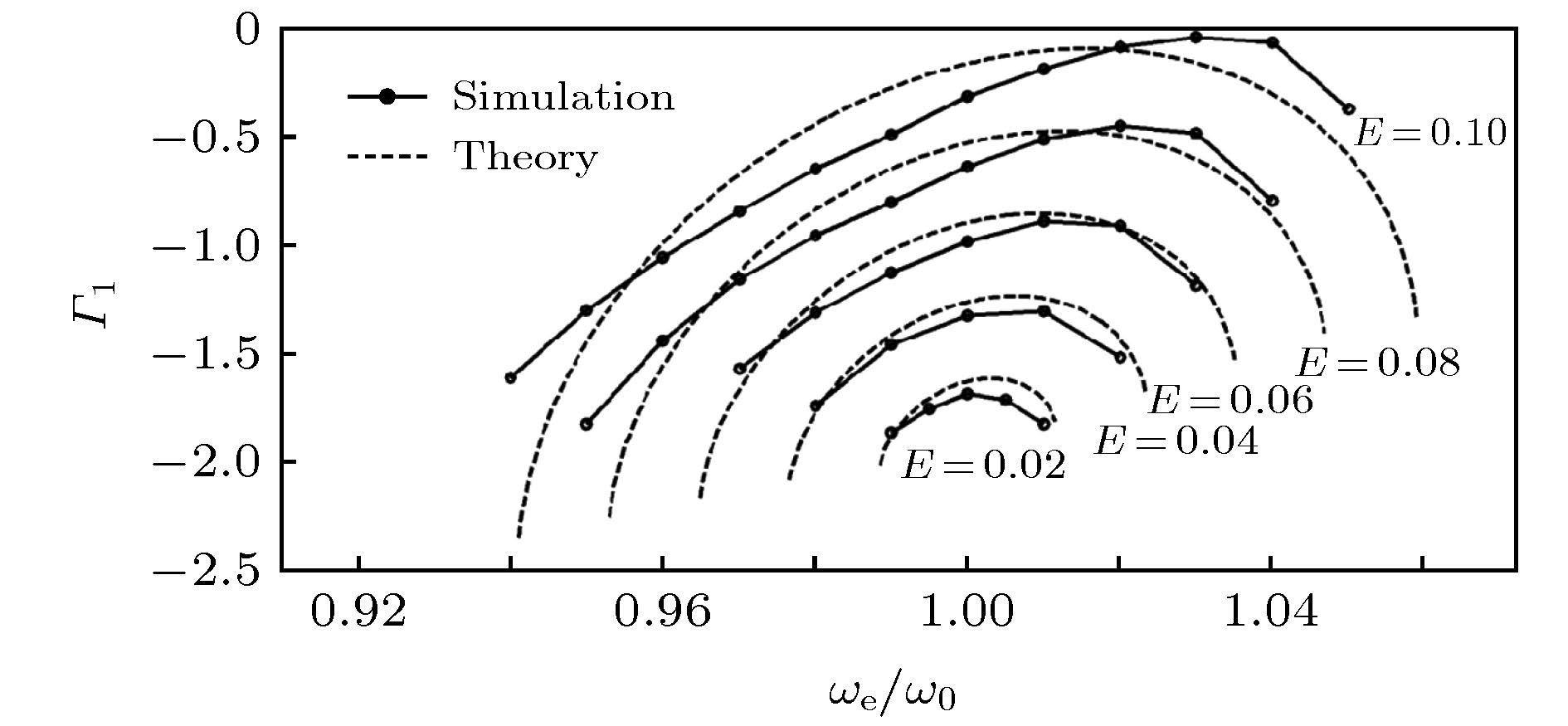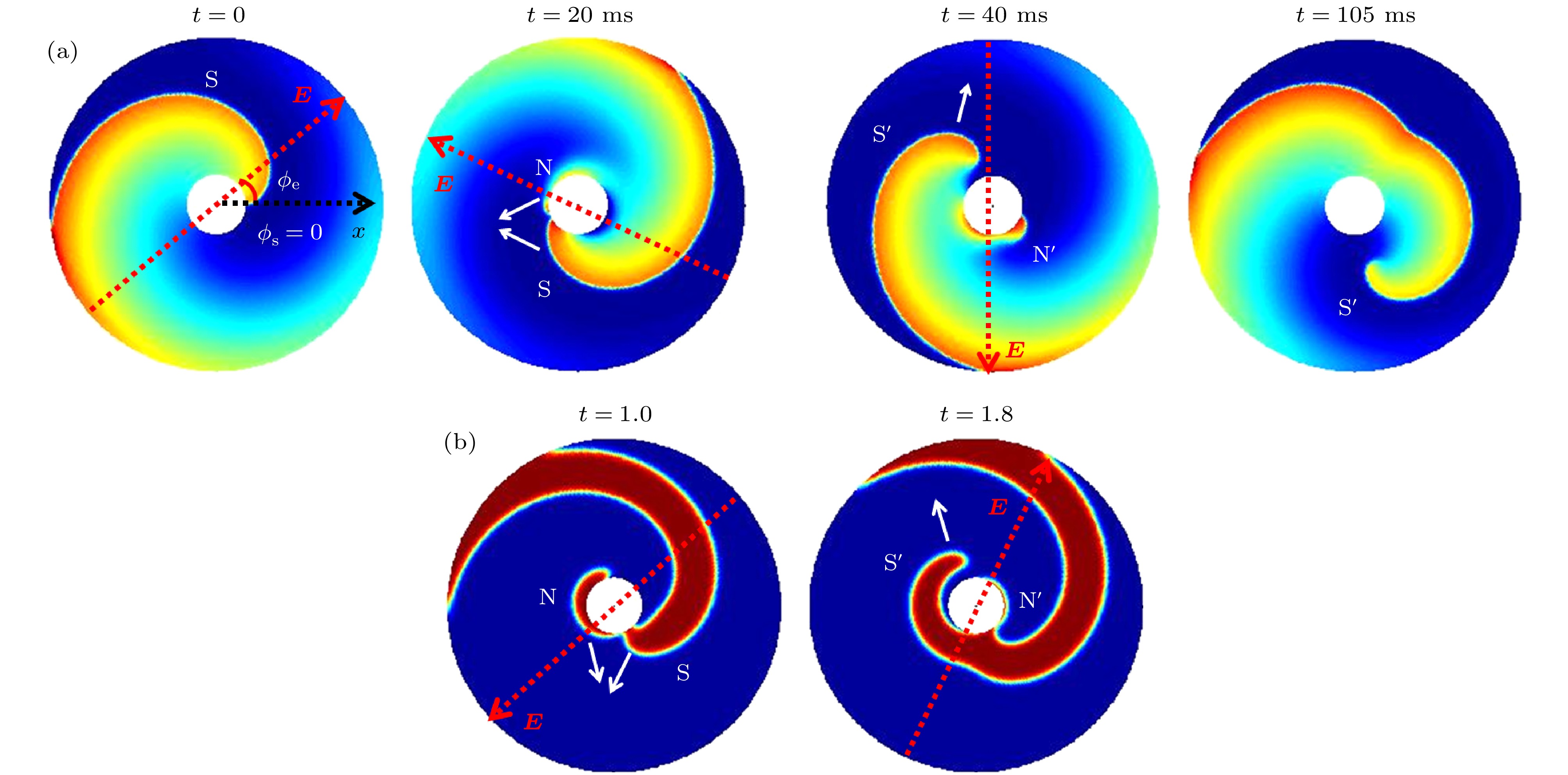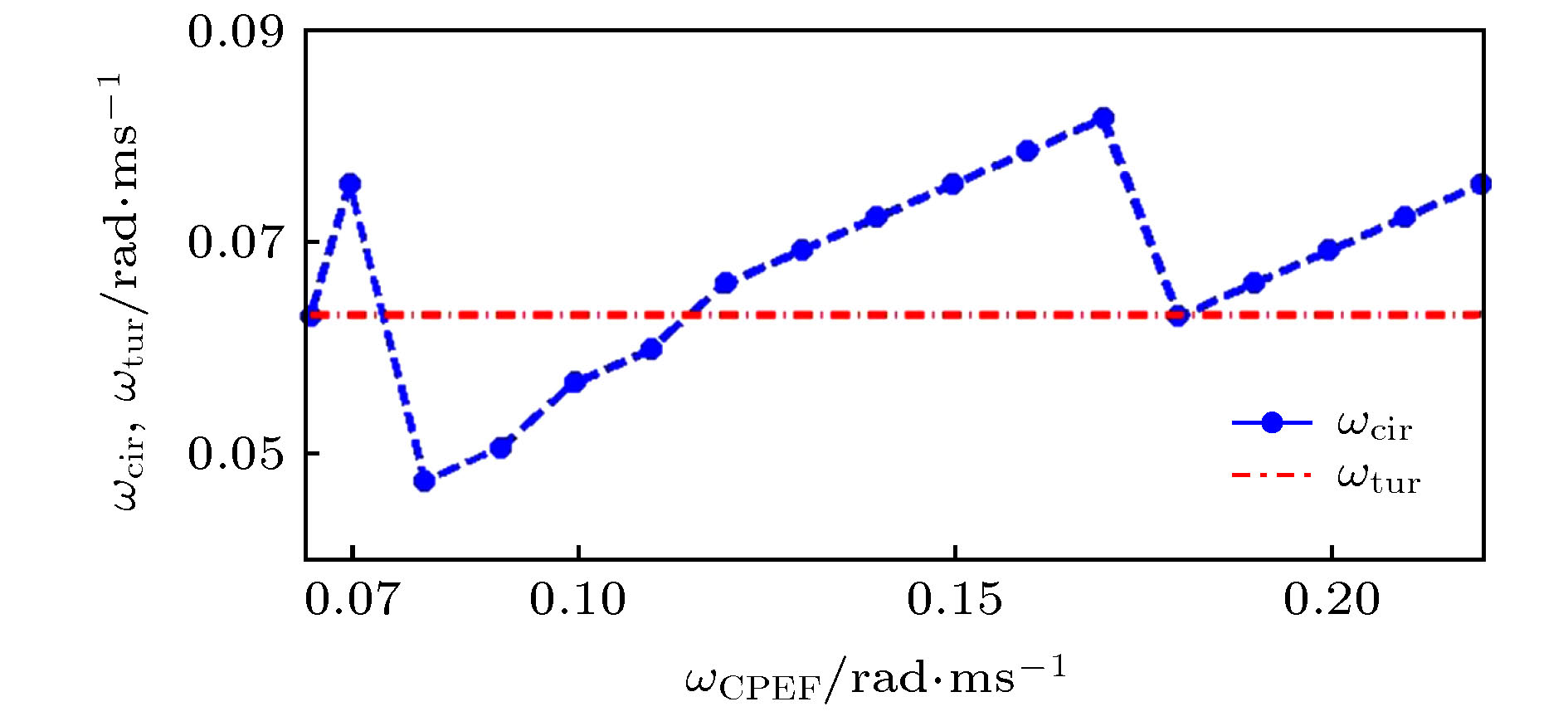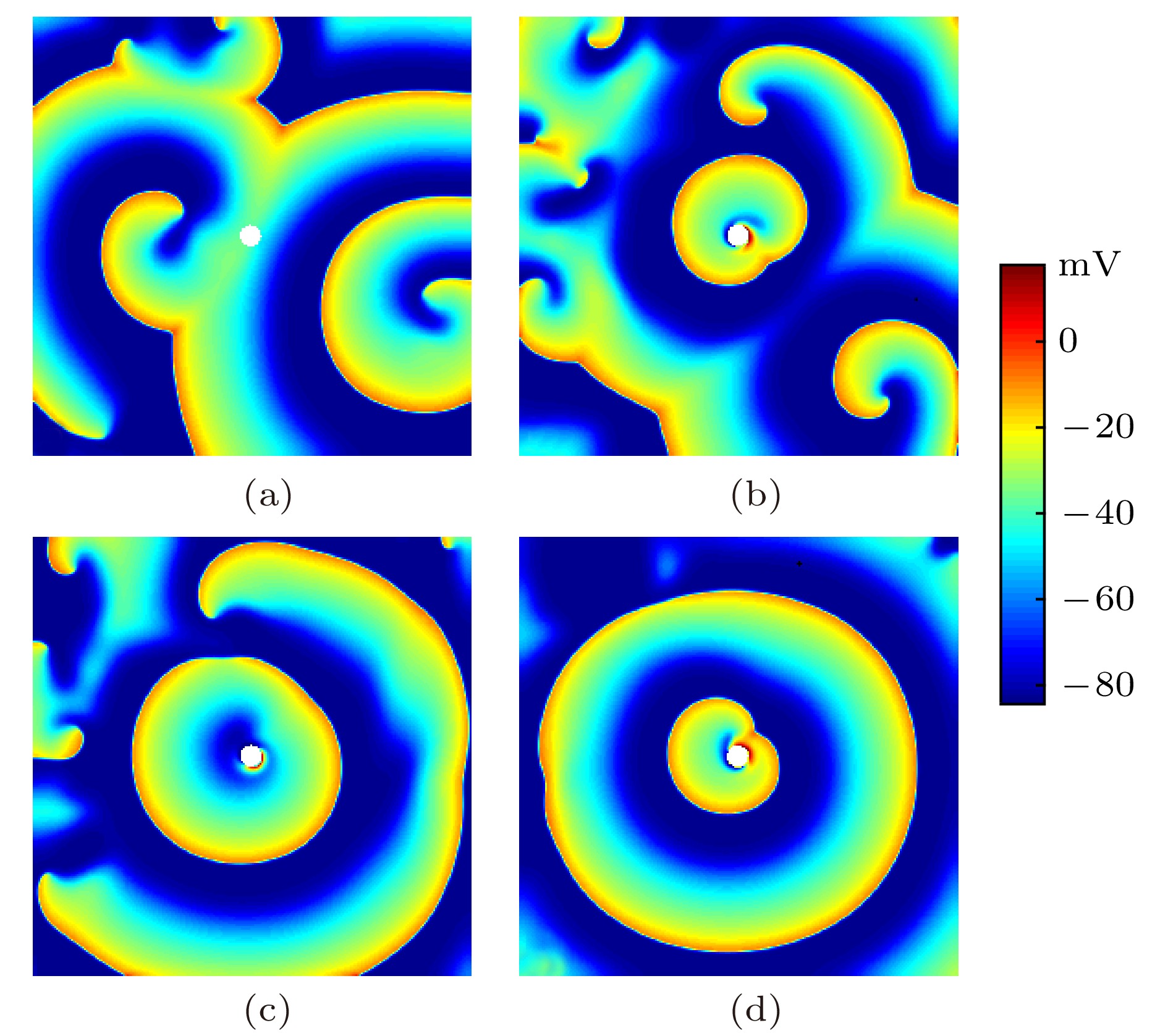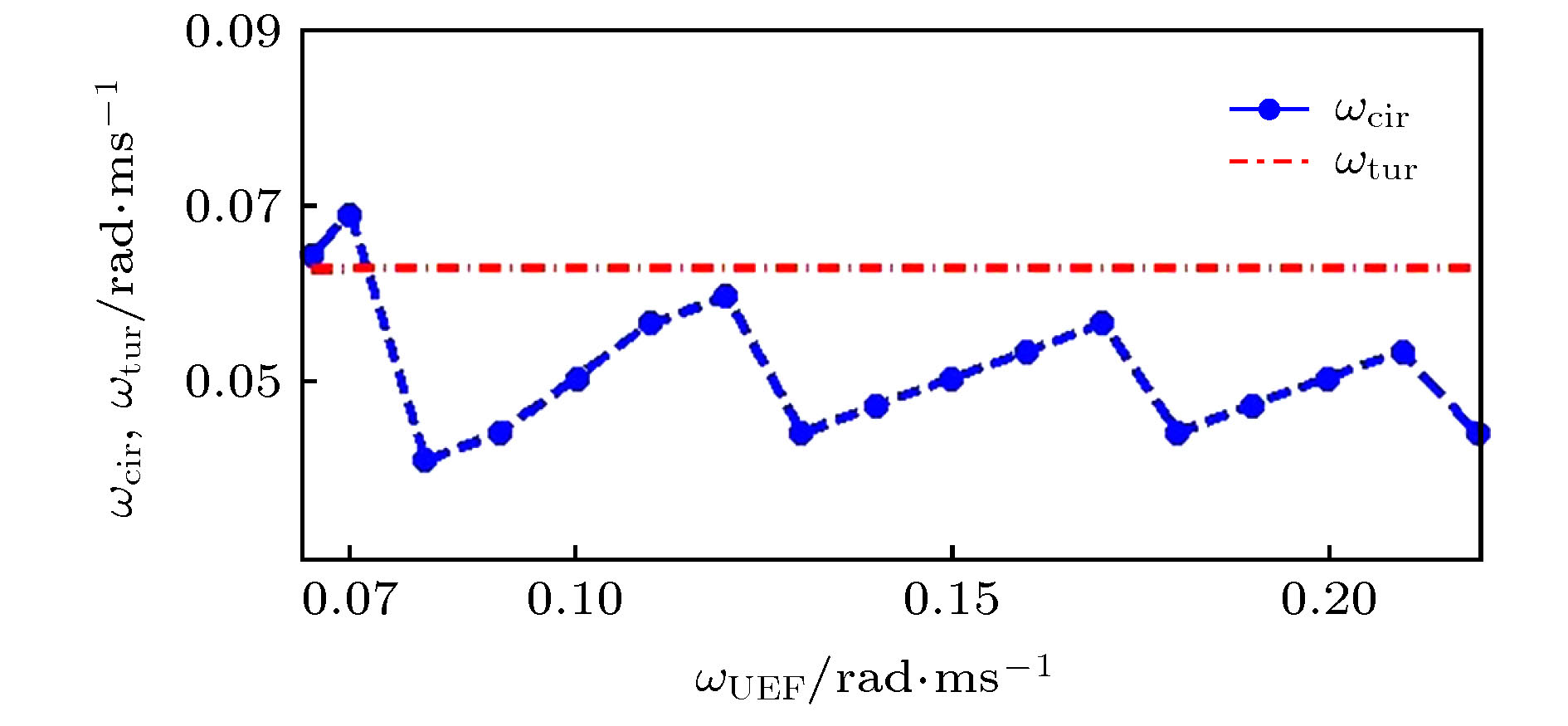-
Spiral waves are ubiquitous in diverse physical, chemical, and biological systems. Periodic external fields, such as polarized electric fields, especially circularly polarized electric fields which possess rotation symmetry may have significant effects on spiral wave dynamics. In this paper, control of spiral waves in excitable media under polarized electric fields is reviewed, including resonant drift, synchronization, chiral symmetry breaking, stabilization of multiarmed spiral waves, spiral waves in subexcitable media, control of scroll wave turbulence, unpinning of spiral waves in cardiac tissues, control of spiral wave turbulence in cardiac tissues, etc.
-
Keywords:
- polarized electric fields /
- excitable media /
- spiral waves /
- control
[1] Winfree A T 2001 The Geometry of Biological Time (2nd ed.) (New York: Springer-Verlag) pp258−302
[2] Winfree A T 1972 Science 175 634
 Google Scholar
Google Scholar
[3] Jakubith S, Rotermund H H, Engel W, von Oertzen A, Ertl G 1990 Phys. Rev. Lett. 65 3013
 Google Scholar
Google Scholar
[4] Gray R A, Pertsov A M, Jalife J 1998 Nature 392 75
 Google Scholar
Google Scholar
[5] Christoph J, Chebbok M, Richter C, Schröder-Schetelig J, Bittihn P, Stein S, Uzelac I, Fenton F H, Hasenfuß G, Gilmour Jr R F, Luther S 2018 Nature 555 667
 Google Scholar
Google Scholar
[6] Steinbock O, Schütze J, Müller S C 1992 Phys. Rev. Lett. 68 248
 Google Scholar
Google Scholar
[7] Muñuzuri A P, Gómez-Gesteira M, Pérez-Muñuzuri V, Krinsky V I, Pérez-Villar V 1994 Phys. Rev. E 50 4258
[8] Zhang H, Hu B, Hu G, Xiao J 2003 J. Chem. Phys. 119 4468
 Google Scholar
Google Scholar
[9] Chen J X, Zhang H, Li Y Q 2006 J. Chem. Phys. 124 014505
 Google Scholar
Google Scholar
[10] Ji L, Zhou Y, Li Q, Qiao C, Ouyang Q 2013 Phys. Rev. E 88 042919
 Google Scholar
Google Scholar
[11] Cai M C, Pan J T, Zhang H 2012 Phys. Rev. E 86 016208
 Google Scholar
Google Scholar
[12] Winfree A T 1991 Chaos 1 303
 Google Scholar
Google Scholar
[13] Krinsky V, Hamm E, Voignier V 1996 Phys. Rev. Lett. 76 3854
 Google Scholar
Google Scholar
[14] Pumir A, Nikolski V, Hörning M, Isomura A, Agladze K, Yoshikawa K, Gilmour R, Bodenschatz E, Krinsky V 2007 Phys. Rev. Lett. 99 208101
 Google Scholar
Google Scholar
[15] Li T C, Gao X, Zheng F F, Pan D B, Zheng B, Zhang H 2017 Sci. Rep. 7 8657
 Google Scholar
Google Scholar
[16] Biktashev V N, Holden A V 1995 Chaos, Solitons Fractals 5 575
 Google Scholar
Google Scholar
[17] Biktasheva I V, Barkley D, Biktashev V N, Bordyugov G V, Foulkes A J 2009 Phys. Rev. E 79 056702
 Google Scholar
Google Scholar
[18] Biktasheva I V, Barkley D, Biktashev V N, Foulkes A J 2010 Phys. Rev. E 81 066202
 Google Scholar
Google Scholar
[19] Pikovsky A, Rosenblum M, Kurths J 2001 Synchronization: A Universal Concept in Nonlinear Sciences (Cambridge: Cambridge University Press) pp65−66
[20] Chen J X, Zhang H, Li Y Q 2009 J. Chem. Phys. 130 124510
 Google Scholar
Google Scholar
[21] Li T C, Li B W, Zheng B, Zhang H, Panfilov A, Dierckx H 2019 New J. Phys. 21 043012
 Google Scholar
Google Scholar
[22] Nicolis G, Prigogine I 1981 Proc. Natl. Acad. Sci. U.S.A. 78 659
 Google Scholar
Google Scholar
[23] Li B W, Deng L Y, Zhang H 2013 Phys. Rev. E 87 042905
 Google Scholar
Google Scholar
[24] Li B W, Cai M C, Zhang H, Panfilov A V, Dierckx H 2014 J. Chem. Phys. 140 184901
 Google Scholar
Google Scholar
[25] Agladze K I, Krinsky V I 1982 Nature 296 424
 Google Scholar
Google Scholar
[26] Vasiev B, Siegert F, Weijer C 1997 Phys. Rev. Lett. 78 2489
 Google Scholar
Google Scholar
[27] Deng L Y, Zhang H, Li Y Q 2009 Phys. Rev. E 79 036107
 Google Scholar
Google Scholar
[28] Mikhailov A S, Zykov V S 1991 Physica D 52 379
 Google Scholar
Google Scholar
[29] Jung P, Mayer-Kress G 1995 Phys. Rev. Lett. 74 2130
 Google Scholar
Google Scholar
[30] Jung P, Mayer-Kress G 1995 Chaos 5 458
 Google Scholar
Google Scholar
[31] Hakim V, Karma A 1999 Phys. Rev. E 60 5073
 Google Scholar
Google Scholar
[32] Biktashev V N, Holden A V, Zhang H 1994 Philos. Trans. R. Soc. London, Ser. A 347 611
 Google Scholar
Google Scholar
[33] Alonso S, Sagués F, Mikhailov A S 2003 Science 299 1722
 Google Scholar
Google Scholar
[34] Zhang H, Cao Z J, Wu N J, Ying H P, Hu G 2005 Phys. Rev. Lett. 94 188301
 Google Scholar
Google Scholar
[35] Li T C, Gao X, Zheng F F, Cai M C, Li B W, Zhang H, Dierckx H 2016 Phys. Rev. E 93 012216
 Google Scholar
Google Scholar
[36] Ripplinger C M, Krinsky V I, Nikolski V P, Efimov I R 2006 Am. J. Physiol. Heart Circ. Physiol. 291 H184
[37] Cysyk J, Tung L 2008 Biophys. J. 94 1533
 Google Scholar
Google Scholar
[38] Fenton F H, Luther S, Cherry E M, Otani N F, Krinsky V, Pumir A, Bodenschatz E, Gilmour Jr R F 2009 Circulation 120 467
 Google Scholar
Google Scholar
[39] Luther S, Fenton F H, Kornreich B G, Squires A, Bittihn P, Hornung D, Zabel M, Flanders J, Gladuli A, Campoy L, Cherry E M, Luther G, Hasenfuss G, Krinsky V I, Pumir A, Gilmour Jr R F, Bodenschatz E 2011 Nature 475 235
 Google Scholar
Google Scholar
[40] Feng X, Gao X, Pan D B, Li B W, Zhang H 2014 Sci. Rep. 4 4831
[41] Jalife J 2000 Annu. Rev. Physiol. 62 25
 Google Scholar
Google Scholar
[42] Koster R W, Dorian P, Chapman F W, Schmitt P W, O'Grady S G, Walker R G 2004 Am. Heart J. 147 e1
[43] Babbs C F, Tacker W A, VanVleet J F, Bourland J D, Geddes L A 1980 Am. Heart J. 99 734
 Google Scholar
Google Scholar
[44] Santini M, Pandozi C, Altamura G, Gentilucci G, Villani M, Scianaro M C, Castro A, Ammirati F, Magris B 1999 J. Interv. Card. Electrophysiol. 3 45
 Google Scholar
Google Scholar
[45] Feng X, Gao X, Tang J M, Pan J T, Zhang H 2015 Sci. Rep. 5 13349
 Google Scholar
Google Scholar
-
图 1 极化电场示意图[11]
${E_x}$ ,${E_y}$ 表示两个相互垂直的交流电场,${E_0}$ ,${\omega _{\rm{e}}}$ 分别是交流电场的振幅和频率,${\phi _{\rm{e}}}$ ,${\phi _{xy}}$ 分别是初相位和相位差Figure 1. Realization sketch of a polarized electric field[11]:
${E_x}$ ,${E_y}$ are two ac electric fields perpendicular to each other, where${E_0}$ ,${\omega _{\rm{e}}}$ are the amplitude and the frequency of the electric field, respectively, and${\phi _{\rm{e}}}$ ,${\phi _{xy}}$ are the initial phase and the phase difference, respectively.图 4 极化电场作用下顺时针旋转螺旋波的漂移[15] (a),(b)顺时针(
${\phi _{xy}} = 0.5{\text{π}}$ )、逆时针(${\phi _{xy}} = 1.5{\text{π}}$ )旋转的圆极化电场作用下螺旋波的漂移, 其中,${\omega _{\rm{e}}} = 2\omega $ ,${\phi _{\rm{e}}} = 0$ ,$\varPhi = 0$ ,$\omega $ 是螺旋波的频率; (c),(d)漂移速率与相位差${\phi _{xy}}$ 的关系, 实线为理论结果, 圆圈为数值结果; (e),(f)漂移角与相位差${\phi _{xy}}$ 的关系, 实线为理论结果, 圆圈为数值结果. 当漂移速率为0(${\phi _{xy}} = 1.5{\text{π}}$ ), 无漂移角; (a),(c),(e)强激发介质; (b),(d),(f)弱激发介质Figure 4. Drifting behaviors of cw spirals under the influence of a polarized electric field[15]: (a),(b) Drifting behaviors of spirals under the influence of a cw (
${\phi _{xy}} = 0.5{\text{π}}$ ) and a counterclockwise (ccw) (${\phi _{xy}} = 1.5{\text{π}}$ ) circularly polarized electric fields (CPEFs) with${\omega _{\rm{e}}} = 2\omega $ ,${\phi _{\rm{e}}} = 0$ ,$\varPhi = 0$ , and$\omega $ being the frequency of the spiral waves; (c),(d) dependence of theoretical (lines) and numerical (circles) drift speeds on the phase difference${\phi _{xy}}$ ; (e),(f) dependence of theoretical (lines) and numerical (circles) drift angles on the phase difference${\phi _{xy}}$ . When the drift speed is 0 (${\phi _{xy}} = 1.5{\text{π}}$ ), the drift angle cannot be defined. (a),(c),(e) Highly excitable medium; (b),(d),(f) Weakly excitable medium.图 7 螺旋波湍流态中的手征对称性破缺[23] (a)螺旋波湍流态中逆时针(黑点)、顺时针(白点)旋转的螺旋波; (b)在逆时针旋转的圆极化电场作用下, 系统中仅存留逆时针旋转的螺旋波; (c)当(b)中的圆极化电场变成顺时针旋转后, 系统中仅存留顺时针旋转的螺旋波.
${\omega _{\rm{e}}} = 1.25$ , E0 = 0.20Figure 7. Coherent state out of defect-mediated turbulence accompanied by chiral symmetry breaking[23]: (a) An initial defect-mediated turbulence state consists of ccw spiral defects (black dots) and cw ones (white dots); (b) coherent state with only ccw spiral waves exists in the asymptotic state when the system is coupled to a ccw CPEF with
${\omega _{\rm{e}}} = 1.25$ and${E_0} = 0.20$ ; (c) similar to (b) but with a cw CPEF, and in such a case, only cw spiral waves survive in the system.图 8 逆时针旋转圆极化电场作用下, 漫游螺旋波对的手征对称性破缺[23] (a)
${E_0} = 0$ ; (b)${E_0} = 0.10$ ,${\omega _{\rm{e}}} = 1.350 > $ ${\omega _0}^{{\rm{ms}}}\;({\omega _0}^{{\rm{ms}}} \approx 1.309) $ , 其中${\omega _0}^{{\rm{ms}}}$ 是无圆极化电场作用下, 漫游螺旋波的主频率; (c)${E_0} = 0.24$ ,${\omega _{\rm{e}}} = 1.307 < {\omega _0}^{{\rm{ms}}}$ ; (d)圆极化电场作用下, 逆时针旋转螺旋波频率${\omega _{\rm{s}}}^{{\rm{ccw}}}$ (实心圆圈)及顺时针旋转螺旋波频率${\omega _{\rm{s}}}^{{\rm{cw}}}$ (空心圆圈)与圆极化电场频率${\omega _{\rm{e}}}$ 的关系, 其中${E_0} = 0.10$ ; (e)圆极化电场作用下, 逆时针旋转螺旋波频率${\omega _{\rm{s}}}^{{\rm{ccw}}}$ (实心圆圈)及顺时针旋转螺旋波频率${\omega _{\rm{s}}}^{{\rm{cw}}}$ (空心圆圈)与圆极化电场强度${E_0}$ 的关系, 其中${\omega _{\rm{e}}} = 1.307$ Figure 8. Symmetry breaking of a meandering spiral pair under a ccw CPEF[23]: (a)
${E_0} = 0$ ; (b)${E_0} = 0.10$ ,${\omega _{\rm{e}}} = 1.350 > $ ${\omega _0}^{{\rm{ms}}}\;({\omega _0}^{{\rm{ms}}} \approx 1.309) $ , where${\omega _0}^{{\rm{ms}}}$ is the principal frequency of the meandering spiral without the CPEF; (c) E0 = 0.24,${\omega _{\rm{e}}} = 1.307 < {\omega _0}^{{\rm{ms}}}$ ; (d) dependence of${\omega _{\rm{s}}}^{{\rm{ccw}}}$ (the frequency of the ccw spiral wave) (full circles) and${\omega _{\rm{s}}}^{{\rm{cw}}}$ (the frequency of the cw spiral wave) (open circles) on${\omega _{\rm{e}}}$ with${E_0} = 0.10$ ;(e) dependence of${\omega _{\rm{s}}}^{{\rm{ccw}}}$ (full circles) and${\omega _{\rm{s}}}^{{\rm{cw}}}$ (open circles) on${E_0}$ with${\omega _{\rm{e}}} = 1.307$ .图 10 圆极化电场对双臂螺旋波作用的相图[27] BU, TS分别表示破碎、稳定区域; SS表示电场过弱, 不足以稳定双臂螺旋波而使其衰退为单臂螺旋波的区域;
${\omega _0} = 1.24$ 是单臂螺旋波的频率Figure 10. The phase diagram for the effects of CPEF on two-armed spiral[27]: BU, TS denote the breakup and the stabi-lization regions, respectively, and SS means the region where the electric field is not strong enough to stabilize the two-armed spiral and it decays into two single-armed spirals. The frequency of the single-armed spiral
${\omega _0} = 1.24$ .图 12 圆极化电场使次激发介质产生螺旋波的机制分析[11],
${E_0} = 0.1$ (a)圆极化电场对螺旋波端点的作用示意图; (b)${c_B} + {c_E}$ 随${\omega _{\rm{e}}}$ 的变化关系; (c)${c_{\rm{t}}}$ 的半解析解与数值解的比较Figure 12. The mechanism analyses for spiral waves sustained by CPEF in subexcitable media[11],
${E_0} = 0.1$ : (a) The sketch of a spiral wave tip submitted to a CPEF; (b) results of${c_B} + {c_E}$ varying with${\omega _{\rm{e}}}$ ; (c) the comparison of the semi-analytical${c_{\rm{t}}}$ with the numerical${c_{\rm{t}}}$ .图 13 圆极化电场作用下, 回卷波湍流态从无序走向有序[35]
${E_0} = 0.4$ ,${\omega _{\rm{e}}} = {\omega _0} = 1.2455$ , 其中${\omega _0}$ 表示螺旋波的频率;$t = 0$ , 施加圆极化电场作用; 黄线表示奇异线Figure 13. Ordering of scroll wave turbulence by switching on a ccw CPEF at
$t = 0$ with${E_0} = 0.4$ and rotation frequency${\omega _{\rm{e}}} = 1.2455$ equal to the natural spiral wave frequency${\omega _0}$ [35]. Filaments are shown in yellow.图 14 圆极化电场抑制(实心圆圈)回卷波湍流态的参数区域中, 电场强度
${E_0}$ 与归一化频率${\omega _{\rm{e}}}/{\omega _0}$ 的关系[35], 交叉表示不能抑制回卷波湍流态Figure 14. Parameter region of scroll wave turbulence suppression (full circles) as a function of external field amplitude
${E_0}$ and normalized frequency${\omega _{\rm{e}}}/{\omega _0}$ [35]. Crosses denote failure of ordering turbulence.图 16 圆极化电场(a)(c)和匀强电场(b)(d)作用下的膜电势分布[40] (a) Luo-Rudy模型,
${E_0} = 0.05\;{\rm{V/cm}}$ ,${\omega _{\rm{e}}} =$ 0.2 rad/ms; (b) Luo-Rudy模型,${E_0} = 0.05\;{\rm{V/cm}}$ ; (c) Barkley模型,${E_0} = 0.05$ ,${\omega _{\rm{e}}} = 4$ ; (d) Barkley模型,${E_0} = 0.05$ . R表示缺陷半径, Luo-Rudy模型中,$R = 0.32\;{\rm{cm}}$ ; Barkley模型中,$R = 3$ . 红色点箭头表示电场方向, 红色曲线箭头表示圆极化电场逆时针旋转. 围绕着缺陷的红色、蓝色分别表示去极化、超极化区域Figure 16. Distribution of the membrane potential induced by CPEF and uniform electric field (UEF)[40]: (a) CPEF in Luo-Rudy model,
${E_0} = 0.05\;{\rm{V/cm}}$ ,${\omega _{\rm{e}}} = 0.2\;{\rm{rad/ms}}$ ; (b) UEF in Luo-Rudy model,${E_0} = 0.05\;{\rm{V/cm}}$ ; (c) CPEF in Barkley model,${E_0} = 0.05$ ,${\omega _{\rm{e}}} = 4$ ; (d) UEF in Barkley model,${E_0} = 0.05$ .In Luo-Rudy model, the obstacle size$R = 0.32\;{\rm{cm}}$ , and in Barkley model,$R = 3$ . The red dotted arrows represent the directions of electric fields. The red curved arrows mean CPEFs rotate counterclockwise. The red and the blue regions around obstacles demonstrate de-polarizations and hyper-polarizations, respectively.图 17 圆极化电场去除顺时针旋转的钉扎螺旋波[40] (a) Luo-Rudy模型, 螺旋波频率
${\omega _{\rm{s}}} = 0.136\;{\rm{rad/ms}}$ , 圆极化电场${E_0} = 0.7\;{\rm{V/cm}}$ ,${\omega _{\rm{e}}} = 0.1\;{\rm{rad/ms}}$ ; 电场作用时间t = 0—46.2 ms, 圆极化电场相对于x轴的初相位为${\phi _{\rm{e}}}$ ; 螺旋波相对于x轴的初相位${\phi _{\rm{s}}} = 0$ ; (b) Barkley模型, 螺旋波频率${\omega _{\rm{s}}} = 1.024$ , 圆极化电场${E_0} = 1.8$ ,${\omega _{\rm{e}}} = 3.686$ ; 电场作用时间t = 0—6. N和N' 表示不同时刻圆极化电场激发产生的激发波, S和S' 分别表示初始的钉扎螺旋波、去钉扎后的螺旋波. 白色箭头表示波的传播方向Figure 17. Unpinning the cw rotating anchored spiral by CPEF[40]: (a) Luo-Rudy model, the frequency of spiral
${\omega _{\rm{s}}} = 0.136\;{\rm{rad/ms}}$ ;${E_0} = 0.7\;{\rm{V/cm}}$ ,${\omega _{\rm{e}}} = 0.1\;{\rm{rad/ms}}$ ; CPEF is applied from$t = 0$ to$t = 46.2\;{\rm{ms}}$ .${\phi _{\rm{e}}}$ is the initial phase of CPEF relative to x axis;${\phi _{\rm{s}}}$ is the initial phase of the anchored spiral front relative to x axis and sets as zero; (b) Barkley model,${\omega _{\rm{s}}} = 1.024$ ,${E_0} = 1.8$ ,${\omega _{\rm{e}}} = 3.686$ ; CPEF is applied from$t = 0$ to$t = 6$ . N and N' represent different new waves nucleated by CPEF in different time. S and S' represent the initial anchord spiral and the new free spiral, respectively. White arrows are the propagation directions of waves图 18 Barkley模型中, 圆极化电场(灰色区域)和匀强电场(阴影区域)去除钉扎螺旋波的适用范围[40] SW, NW, RW和BI分别表示螺旋波、无波、收缩波和双稳区域; 圆极化电场
${E_0} = 1.8$ ,${\omega _{\rm{e}}} = 3.6\;{\omega _{\rm{s}}}$ ; 匀强电场${E_0} = 7$ Figure 18. Unpinning scope of CPEF (gray) and UEF (shaded) in Barkley model[40]: SW, NW, RW and BI regions represent spiral waves, no wave, retracting waves and bi-stability, respectively; for CPEF,
${E_0} = 1.8$ ,${\omega _{\rm{e}}} = 3.6\;{\omega _{\rm{s}}}$ and for UEF,${E_0} = 7$ .图 19 静息态下圆极化电场及其激发产生的圆形波列之间的频率关系[45]
${E_0} = 1.0\;{\rm{V/cm}}$ ,$0.065\;{\rm{rad/ms}} \leqslant {\omega _{{\rm{CPEF}}}} \leqslant $ 0.22 rad/ms;${\omega _{{\rm{cir}}}}$ 是圆形波列的频率;${\omega _{{\rm{tur}}}}$ 是螺旋波湍流态的主频率Figure 19. The frequency relations between the circular wave train and CPEF in a two-dimensional quiescent medium[45]:
${E_0} = 1.0\;{\rm{V/cm}}$ ,$0.065\;{\rm{rad/ms}} \leqslant {\omega _{{\rm{CPEF}}}} \leqslant $ 0.22 rad/ms;${\omega _{{\rm{cir}}}}$ is the frequency of the circular wave trains, and${\omega _{{\rm{tur}}}}$ is the dominant frequency of the spiral turbulence.图 20 圆极化电场抑制螺旋波湍流态[45]
${E_0} = 1.0\;{\rm{V/cm}}$ ,${\omega _{{\rm{CPEF}}}} = 0.14\;{\rm{rad/ms}}$ (a) t = 0; (b) t = 1000 ms; (c) t = 1800 ms; (d) t = 2800 msFigure 20. Suppression of spiral turbulence by CPEF[45]:
${E_0} = 1.0\;{\rm{V/cm}}$ ,${\omega _{{\rm{CPEF}}}} = 0.14\;{\rm{rad/ms}}$ : (a) t = 0; (b) t = 1000 ms; (c) t = 1800 ms; (d) t = 2800 ms.图 21 静息态下匀强电场及其激发产生的圆形波列之间的频率关系[45]
${E_0} = 1.0\;{\rm{V/cm}}$ ,$0.065\;{\rm{rad/ms}} \leqslant {\omega _{{\rm{UEF}}}} \leqslant $ 0.22 rad/ms; 脉冲间隔为$10\;{\rm{ms}}$ ;${\omega _{{\rm{cir}}}}$ 是圆形波列的频率;${\omega _{{\rm{tur}}}}$ 是螺旋波湍流态的主频率Figure 21. The frequency relations between the circular wave train and UEF in a two-dimensional quiescent medium[45]:
${E_0} = 1.0\;{\rm{V/cm}}$ ,$0.065\;{\rm{rad/ms}} \leqslant {\omega _{{\rm{CPEF}}}} \leqslant 0.22\;{\rm{rad/ms}}$ ; the pulse duration is$10\;{\rm{ms}}$ ;${\omega _{{\rm{cir}}}}$ is the frequency of the circular wave trains, and${\omega _{{\rm{tur}}}}$ is the dominant frequency of the spiral turbulence. -
[1] Winfree A T 2001 The Geometry of Biological Time (2nd ed.) (New York: Springer-Verlag) pp258−302
[2] Winfree A T 1972 Science 175 634
 Google Scholar
Google Scholar
[3] Jakubith S, Rotermund H H, Engel W, von Oertzen A, Ertl G 1990 Phys. Rev. Lett. 65 3013
 Google Scholar
Google Scholar
[4] Gray R A, Pertsov A M, Jalife J 1998 Nature 392 75
 Google Scholar
Google Scholar
[5] Christoph J, Chebbok M, Richter C, Schröder-Schetelig J, Bittihn P, Stein S, Uzelac I, Fenton F H, Hasenfuß G, Gilmour Jr R F, Luther S 2018 Nature 555 667
 Google Scholar
Google Scholar
[6] Steinbock O, Schütze J, Müller S C 1992 Phys. Rev. Lett. 68 248
 Google Scholar
Google Scholar
[7] Muñuzuri A P, Gómez-Gesteira M, Pérez-Muñuzuri V, Krinsky V I, Pérez-Villar V 1994 Phys. Rev. E 50 4258
[8] Zhang H, Hu B, Hu G, Xiao J 2003 J. Chem. Phys. 119 4468
 Google Scholar
Google Scholar
[9] Chen J X, Zhang H, Li Y Q 2006 J. Chem. Phys. 124 014505
 Google Scholar
Google Scholar
[10] Ji L, Zhou Y, Li Q, Qiao C, Ouyang Q 2013 Phys. Rev. E 88 042919
 Google Scholar
Google Scholar
[11] Cai M C, Pan J T, Zhang H 2012 Phys. Rev. E 86 016208
 Google Scholar
Google Scholar
[12] Winfree A T 1991 Chaos 1 303
 Google Scholar
Google Scholar
[13] Krinsky V, Hamm E, Voignier V 1996 Phys. Rev. Lett. 76 3854
 Google Scholar
Google Scholar
[14] Pumir A, Nikolski V, Hörning M, Isomura A, Agladze K, Yoshikawa K, Gilmour R, Bodenschatz E, Krinsky V 2007 Phys. Rev. Lett. 99 208101
 Google Scholar
Google Scholar
[15] Li T C, Gao X, Zheng F F, Pan D B, Zheng B, Zhang H 2017 Sci. Rep. 7 8657
 Google Scholar
Google Scholar
[16] Biktashev V N, Holden A V 1995 Chaos, Solitons Fractals 5 575
 Google Scholar
Google Scholar
[17] Biktasheva I V, Barkley D, Biktashev V N, Bordyugov G V, Foulkes A J 2009 Phys. Rev. E 79 056702
 Google Scholar
Google Scholar
[18] Biktasheva I V, Barkley D, Biktashev V N, Foulkes A J 2010 Phys. Rev. E 81 066202
 Google Scholar
Google Scholar
[19] Pikovsky A, Rosenblum M, Kurths J 2001 Synchronization: A Universal Concept in Nonlinear Sciences (Cambridge: Cambridge University Press) pp65−66
[20] Chen J X, Zhang H, Li Y Q 2009 J. Chem. Phys. 130 124510
 Google Scholar
Google Scholar
[21] Li T C, Li B W, Zheng B, Zhang H, Panfilov A, Dierckx H 2019 New J. Phys. 21 043012
 Google Scholar
Google Scholar
[22] Nicolis G, Prigogine I 1981 Proc. Natl. Acad. Sci. U.S.A. 78 659
 Google Scholar
Google Scholar
[23] Li B W, Deng L Y, Zhang H 2013 Phys. Rev. E 87 042905
 Google Scholar
Google Scholar
[24] Li B W, Cai M C, Zhang H, Panfilov A V, Dierckx H 2014 J. Chem. Phys. 140 184901
 Google Scholar
Google Scholar
[25] Agladze K I, Krinsky V I 1982 Nature 296 424
 Google Scholar
Google Scholar
[26] Vasiev B, Siegert F, Weijer C 1997 Phys. Rev. Lett. 78 2489
 Google Scholar
Google Scholar
[27] Deng L Y, Zhang H, Li Y Q 2009 Phys. Rev. E 79 036107
 Google Scholar
Google Scholar
[28] Mikhailov A S, Zykov V S 1991 Physica D 52 379
 Google Scholar
Google Scholar
[29] Jung P, Mayer-Kress G 1995 Phys. Rev. Lett. 74 2130
 Google Scholar
Google Scholar
[30] Jung P, Mayer-Kress G 1995 Chaos 5 458
 Google Scholar
Google Scholar
[31] Hakim V, Karma A 1999 Phys. Rev. E 60 5073
 Google Scholar
Google Scholar
[32] Biktashev V N, Holden A V, Zhang H 1994 Philos. Trans. R. Soc. London, Ser. A 347 611
 Google Scholar
Google Scholar
[33] Alonso S, Sagués F, Mikhailov A S 2003 Science 299 1722
 Google Scholar
Google Scholar
[34] Zhang H, Cao Z J, Wu N J, Ying H P, Hu G 2005 Phys. Rev. Lett. 94 188301
 Google Scholar
Google Scholar
[35] Li T C, Gao X, Zheng F F, Cai M C, Li B W, Zhang H, Dierckx H 2016 Phys. Rev. E 93 012216
 Google Scholar
Google Scholar
[36] Ripplinger C M, Krinsky V I, Nikolski V P, Efimov I R 2006 Am. J. Physiol. Heart Circ. Physiol. 291 H184
[37] Cysyk J, Tung L 2008 Biophys. J. 94 1533
 Google Scholar
Google Scholar
[38] Fenton F H, Luther S, Cherry E M, Otani N F, Krinsky V, Pumir A, Bodenschatz E, Gilmour Jr R F 2009 Circulation 120 467
 Google Scholar
Google Scholar
[39] Luther S, Fenton F H, Kornreich B G, Squires A, Bittihn P, Hornung D, Zabel M, Flanders J, Gladuli A, Campoy L, Cherry E M, Luther G, Hasenfuss G, Krinsky V I, Pumir A, Gilmour Jr R F, Bodenschatz E 2011 Nature 475 235
 Google Scholar
Google Scholar
[40] Feng X, Gao X, Pan D B, Li B W, Zhang H 2014 Sci. Rep. 4 4831
[41] Jalife J 2000 Annu. Rev. Physiol. 62 25
 Google Scholar
Google Scholar
[42] Koster R W, Dorian P, Chapman F W, Schmitt P W, O'Grady S G, Walker R G 2004 Am. Heart J. 147 e1
[43] Babbs C F, Tacker W A, VanVleet J F, Bourland J D, Geddes L A 1980 Am. Heart J. 99 734
 Google Scholar
Google Scholar
[44] Santini M, Pandozi C, Altamura G, Gentilucci G, Villani M, Scianaro M C, Castro A, Ammirati F, Magris B 1999 J. Interv. Card. Electrophysiol. 3 45
 Google Scholar
Google Scholar
[45] Feng X, Gao X, Tang J M, Pan J T, Zhang H 2015 Sci. Rep. 5 13349
 Google Scholar
Google Scholar
Catalog
Metrics
- Abstract views: 21685
- PDF Downloads: 238
- Cited By: 0



























 DownLoad:
DownLoad:
